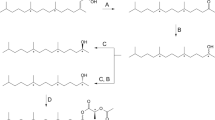Abstract
Heliothis armigera andSpodoptera littoralis females produced sex pheromone during their scotophase. Maximum levels of pheromone in Heliothisarmigera were extracted from 2- to 3-day-old females during their 4.5-hr scotophase. On ligation between the head and the thorax of both species, normal pheromone production was inhibited. Homogenates of brains (consisting of brains, subesophageal ganglia, corpora cardiaca, and corpora allata) from both species induced a normal level of pheromone production by ligated females. Moreover, inS. littoralis, female brain hormone induced the production of the two components (Z)-9- and (Z, E)-9,11-tetradecenyl acetate tested by gas chromatography. Partial separation of brain homogenates, using low pressure C18-silica reversed-phase columns, produced a stable and active hormone source that gave a dose-dependent response. This hormone was found in brain extracts of both male and femaleH. armigera andS. littoralis females. In addition,S. littoralis induced pheromone production byH. armigera ligated females.
Similar content being viewed by others
References
Arai, K., Ando, T., Tatsuki, S., Usul, K., Ohguchi, Y., Kurihara, M., Fukami, J., andTakahashi, N. 1984. The biosynthetic pathway of (Z)-11-Hexadecenal, the sex pheromone compound of the rice stem borer,Chilo suppressalis Walker (Lepidoptera: Pyralidae).Agric. Biol. Chem. 48:3165–3168.
Baker, T.C., andCardé, R.T. 1979. Endogenous and exogenous factors affecting periodicities of female calling and male sex pheromone response inGrapholita molesta.J. Insect Physiol. 25:943–950.
Bjostad, L.B., andRoelofs, W.L. 1983. Sex pheromone biosynthesis inTrichoplusia ni: Key steps involve delta-11 desaturation and chain shortening.Science 220:1387–1389.
Blomquist, G.J., andDillwith, J.W. 1983. Pheromones: biochemistry and physiology, pp. 527–542,in R.G.H. Downs, and H. Laufer (eds.). Endocrinology of Insects. Alan R. Liss, New York.
Cardé, R.T., andWebster, R.P. 1981. Endogenous factors controlling insect sex pheromone production and response, particularly in the Lepidoptera, pp. 977–990,in M. Kloza (ed.). Regulation of Insect Development and Behavior. International Conference. Wyroclaw, Technical University Press.
Dunkelblum, E., Tan, S.H., andSilk, P.J. 1985. Double-bond location in monounsaturated fatty acids by dimethyl disulfide derivatization and mass spectrometry: Application of analysis of fatty acids in pheromone glands of our Lepidoptera.J. Chem. Ecol. 11:265–277.
Jaffe, H., Raina, A.K., andHayes, D.K. 1986. HPLC isolation and purification of pheromone biosynthesis activating neuropeptide ofHeliothis zea, pp. 219–224,in A.B. Borkovec and D.B. Gelman (eds.). Insect Neurochemistry and Neurophysiology. Humana Press, Clifton, New Jersey.
Ohguchi, Y., Tatsuki, S., Usui, K., Arai, K., Kurihara, M., Uchiumi, K., andFukami, J. 1985. Hormone-like substance present in the cephalic organs of the female moth,Chilo suppressalis (Walker) (Lepidoptera: Pyralidae) and controlling sex pheromone production.Jpn. J. Appl. Entomol. Zool. 29:265–269.
Rafaeli, A., Raina, A.K., andKlun, J.A. 1985. Neuroendocrine control of sex pheromone productionin Heliothis sp.Phytoparasitica 13:146–147.
Raina, A.K., andKlun, J.A. 1984a. Neuro-hormonal control of sex pheromone production inHeliothis zea, pp. 467–469,in A.B. Borkovec and T.J. Kelly (eds.). Insect Neurochemistry and Neurophysiology. Plenum Press, New York.
Raina, A.K., andKlun, J.A. 1984b. Brain factor control of sex pheromone production in the female corn earworm moth.Science 225:531–533.
Raina, A.K., Klun, J.A., andStadelbacher, E.A. 1986. Diel periodicity and effect of age and mating on female sex pheromone titer inHeliothis zea (Lepidoptera: Noctuidae).Ann. Ent. Soc. Am. 79:128–131.
Raina, A.K., Jaffe, H., Klun, J.A., Ridgway, R.L., andHayes, D.K. 1987. Characteristics of a neurohormone that controls sex pheromone production inHeliothis zea.J. Insect Physiol. 33:809–814.
SAS User's Guide: Statistics 1982. SAS Institutes Inc.
Webster, R.P., andCardé, R.T. 1984. The effects of mating, exogenous juvenile hormone, and a juvenile hormone analogue on pheromone titre, calling and oviposition in the omnivorous leafroller moth (Platynota stultana).J. Insect Physiol. 30:113–118.
Author information
Authors and Affiliations
Rights and permissions
About this article
Cite this article
Rafaeli, A., Soroker, V. Influence of diel rhythm and brain hormone on pheromone production in two lepidopteran species. J Chem Ecol 15, 447–455 (1989). https://doi.org/10.1007/BF01014691
Received:
Accepted:
Issue Date:
DOI: https://doi.org/10.1007/BF01014691




